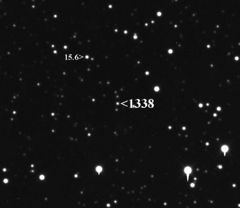1338 Duponta

|
|
| Discovery | |
|---|---|
| Discovered by | Boyer, L. |
| Discovery site | Algiers |
| Discovery date | 4 December 1934 |
| Designations | |
| MPC designation | (1338) Duponta |
| 1934 XA | |
| Orbital characteristics | |
| Epoch 31 July 2016 (JD 2457600.5) | |
| Uncertainty parameter 0 | |
| Observation arc | 81.04 yr (29600 days) |
| Aphelion | 2.5173069 AU (376.58375 Gm) |
| Perihelion | 2.0103327 AU (300.74149 Gm) |
| 2.263820 AU (338.6627 Gm) | |
| Eccentricity | 0.1119732 |
| 3.41 yr (1244.1 d) | |
| 347.30828° | |
| 0° 17m 21.703s / day | |
| Inclination | 4.818293° |
| 325.63706° | |
| 110.44936° | |
| Known satellites | 1 |
| Earth MOID | 1.02997 AU (154.081 Gm) |
| Jupiter MOID | 2.69091 AU (402.554 Gm) |
| Jupiter Tisserand parameter | 3.605 |
| Physical characteristics | |
| Dimensions | 8 km - 19 km |
| 3.85453 h (0.160605 d) | |
| 12.6 | |
1338 Duponta (1934 XA) is a main-belt asteroid discovered on December 4, 1934, by Boyer, L. at Algiers. Since the albedo of this asteroid is unknown, the size can only be estimated as between about 8 km - 19 km, based on the absolute magnitude (H) of 12.3.
Photometric observations in 2007 revealed a ~3 km satellite (diameter ratio of 0.23) with an orbital period of 17.57 hours. Due to the similar size of the primary and secondary the Minor Planet Center lists this as a binary companion.
...
Wikipedia
